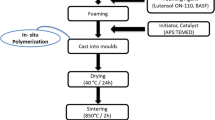Abstract
For reconstruction of bone defects resulting from the treatment of bone fractures or tumors or for the reconstruction of bone tissues following the surgery of organs or the like, biomaterials, including metals, polymers and ceramics, have been used. In this study, among ceramic materials, biphasic calcium phosphate (BCP) consisting of hydroxyapatite having excellent bioactivity and osteoconductivity, and β-tricalcium phosphate having high biodegradability, were mixed at a ratio of 60:40, which is suitable for new bone formation. To manufacture porous BCP scaffold, which has interconnected pores and is suitable for tissue regeneration and reconstruction, a polyurethane foaming (gas foaming) fabrication was applied to manufacture a bone scaffold satisfying various functional requirements. As the results, bone scaffolds having a pore size ranging from 300 μm to 800 μm and a porosity ranging from 75% to 85% could be manufactured using this process. In in vitro and in vivo animal tests, it was confirmed that the scaffold manufactured in this study can be effectively used as a bone scaffold, which is biocompatible and has the ability to induce bone differentiation and regeneration.
Similar content being viewed by others
References
BS Kim, IK Park, T Hoshiba, et al., Design of artificial extracellular matrices for tissue engineering, Progress in Polymer Science, 36, 2 (2011).
H Yoshikawa, A Myoui, Bone tissue engineering with porous hydroxyapatite ceramics, J Artif Organs, 8, 131 (2005).
LL Hench, Bioactive materials: the potential for tissue regeneration, J Biomed Mater Res, 41, 4 (1998).
X Yu, S Cai, G Xu, et al., Low temperature fabrication of high strength porous calcium phosphate and the evaluation of the osteoconductivity, J Mater Sci Mater Med, 20, 10 (2009).
RA Ayers, SJ Simske, CR Nunes, et al., Long-term bone ingrowth and residual micro hardness of porous block hydroxyapatite implants in humans, J Oral Maxillofac Surg, 56, 11 (1998).
FZ Zhang, K Kato, M Fuji, et al., Gelcasting fabrication of porous ceramics using a continuous process, J Eur Ceram Soc, 26, 4 (2006).
P Sepulceda, Gelcasting foams for porous ceramics, Am Ceram Soc Bull, 76, 10 (1997).
SW Yook, HE Kim, BH Yoon, et al., Improvement of compressive strength of porous hydroxyapatite scaffolds by adding polystyrene to camphene-based slurries, Mater Lett, 63, 11 (2009).
O Lyckfeldt, JMP Ferreira, Processing of porous ceramics by starch consolidation, J Eur Ceram Soc, 18, 2 (1998).
A Muthutantri, J Huang, M Edirisinghe, Nobel method of preparing hydroxyapatite foams, J Mater Sci Mater Med, 19, 4 (2008).
J Zhao, S Xiao, X Lu, et al., A study on improving mechanical properties of porous HA tissue engineering scaffolds by hot isotatic pressing, Biomed Mater, 1, 4 (2006).
IK Jun, JH Song, WY Choi, et al., Porous hydroxyapatite scaffolds coated with bioactive apatite-wollastonite glass-ceramics, J Am Ceram Soc, 90, 9 (2007).
HW Kim, JC Knowles, HE Kim, Hydroxyapatite porous scaffold engineered with biological polymer hybrid coating for antibiotic vancomycin release, J Mater Sci Mater Med, 16, 3 (2005).
X Huang, X Miao, Novel porous hydroxyapatite prepared by combining H2O2 foaming with PU sponge and modified with PLGA and bioactive glass, J Biomater Appl, 21, 4 (2007).
KL Calvert, TJ Webster, LA Kirkpatrick, Characterization of commercial rigid polyurethane foams used as bone analogs for implant testing, J Mater Sci Mater Med, 21, 5 (2010).
YS Cho, JW Lee, JS Lee, et al., Hyaluronic acid and silver sulfadiazine-impregnated polyurethane forms for wound dressing application, J Mater Sci Mater Med, 13, 9 (2002).
HR Ramay, M Zhang, Preparation of porous hydroxyapatite scaffolds by combination of the gel-casting and polymer sponge methods, Biomaterials, 24, 19 (2003).
CC Xu, RW Chan, Pore architecture of a bovine acellular vocal fold scaffold, Tissue Eng Part A, 14, 11 (2008).
X Xin, M Hussain, JJ Mao, Continuing differentiation of human mesenchymol stem cells and induced chondrogenic and osteogenic lineages in electrospun PLGA nanofiber scaffold, Biomaterials, 28, 2 (2007).
Y Yonekura, H Miyamoto, T Shimagaki, et al., Osteoconductivity of thermal-sprayed silver-containing hydroxyapatite coating in the rat tibia, J Bone Joint Surg Br, 93-B, 5 (2011).
Author information
Authors and Affiliations
Corresponding author
Rights and permissions
About this article
Cite this article
Kim, H.J., Park, I.K., Kim, J.H. et al. Gas foaming fabrication of porous biphasic calcium phosphate for bone regeneration. Tissue Eng Regen Med 9, 63–68 (2012). https://doi.org/10.1007/s13770-012-0022-8
Received:
Revised:
Accepted:
Published:
Issue Date:
DOI: https://doi.org/10.1007/s13770-012-0022-8




